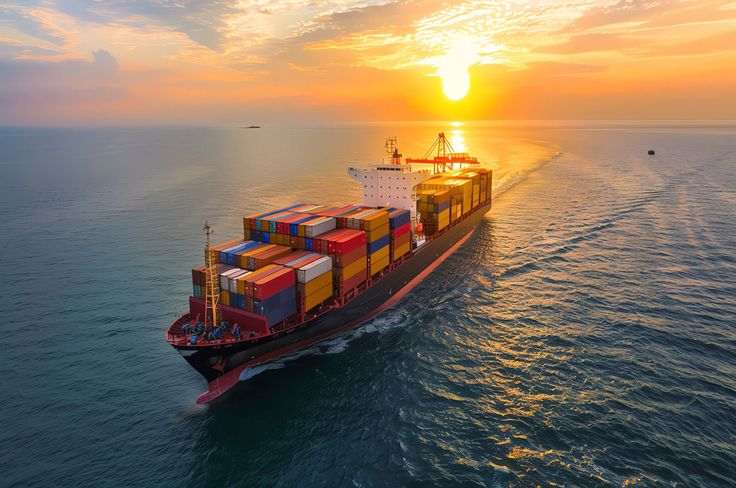- By TOP CHINA FREIGHT
- August 13, 2025
- Shipping
Shipping from China to USA by sea remains one of the most widely used methods of international trade. It is cost-effective, reliable, and ideal for bulk shipments. In this guide, we will cover everything you need to know about shipping from China to USA by sea, including transportation details, costs, port selection, shipping methods, and customs proceduresto help businesses make informed decisions.

1.What is Sea Freight?
Sea freight refers to transporting goods using large cargo ships. It is especially suitable for heavy or bulky cargo that would be too expensive to send by air. Shipping from China to USA by sea is preferred by businesses because:
- It reduces overall logistics costs per unit.
- Ships have larger capacity than planes, allowing for more flexible shipping schedules.
- It can handle a wide range of cargo, from raw materials to finished products.
Unlike air freight, sea freight may take longer, but it is more economical for long-distance international shipping.
2.Main Ports for Shipping from China to USA
China has several major ports for sea freight to the USA. Choosing the right port can significantly affect transit time and shipping cost:
| Chinese Port | Major U.S. Destinations | Transit Time (Approx.) |
|---|---|---|
| Shanghai | Los Angeles, Seattle, New York | 15–25 days (West Coast), 30–40 days (East Coast) |
| Shenzhen | Los Angeles, San Francisco | 18–28 days |
| Ningbo | Houston, Savannah | 25–35 days |
| Guangzhou | Seattle, Long Beach | 20–30 days |
Transit times vary depending on shipping lines, vessel schedules, and customs clearance. Planning ahead is crucial to avoid delays.
3.Shipping Methods: FCL vs LCL
Shipping from China to USA by sea can be done using either Full Container Load (FCL) or Less than Container Load (LCL). Understanding the difference is key:
| Shipping Method | Description | Best For | Pros | Cons |
|---|---|---|---|---|
| FCL (Full Container Load) | Entire container dedicated to one shipment | Large shipments (20ft or 40ft containers) | Faster, more secure, fewer handling points | Higher upfront cost if shipment is small |
| LCL (Less than Container Load) | Multiple shipments share the same container | Small shipments or startups | Cost-effective for small cargo, flexible volume | Longer transit due to consolidation and deconsolidation |
Choosing FCL is usually more efficient for bulk shipments, while LCL is ideal for small or irregular cargo volumes.
4.Factors Affecting Costs
The cost of shipping from China to USA by sea depends on several factors:
1.Container Type:
20ft or 40ft containers are most common. Refrigerated containers cost more.
2.Cargo Weight & Volume:
LCL charges are based on volume; FCL charges are flat per container.
3.Port Fees & Handling:
Terminal handling, documentation fees, and customs duties affect the total cost.
4.Seasonal Demand:
Peak shipping seasons (August–November) can increase costs.
5.Insurance:
Protects against cargo damage or loss during transit.
Estimated Costs per 20ft Container:
$1,200–$1,850
Estimated Costs per 40ft Container:
$2,000–$3,200
5.Transportation Details: How Goods Move
| Stage | Description | Estimated Timeframe |
|---|---|---|
| Port Pickup | Goods are transported from the supplier or factory to the nearest port. | 1–3 days |
| Customs Clearance in China | Export documentation is verified before cargo is loaded onto ships. | 1–2 days |
| Ocean Transit | Cargo is shipped across the Pacific Ocean. | 15–40 days (depending on destination) |
| US Port Arrival & Customs | Cargo undergoes import clearance, duties are paid, and containers are inspected. | 2–5 days |
| Final Delivery | Goods are transported via truck or rail to the buyer’s warehouse. | 2–7 days (depending on location) |
6.Advantages of Shipping by Sea
1.Economical for Large Shipments:
Less cost per kilogram compared to air freight.
2.High Capacity:
Ships carry thousands of tons of cargo.
3.Sustainable Transport:
Modern vessels use fuel-efficient engines, reducing carbon emissions.
4.Security:
FCL shipments are sealed and less prone to damage or theft.
7.Common Challenges
While sea freight has many advantages, there are challenges:
- Longer Transit Times: Delays due to weather, port congestion, or customs inspections.
- Documentation Errors: Missing paperwork can lead to shipment holdups.
- Cost Fluctuations: Fuel prices, peak seasons, and tariffs affect shipping costs.
- Cargo Insurance: Essential due to long transit durations.
8.Tips for Optimizing Sea Freight
Avoid peak season delays by scheduling shipments early.
Use tracking tools to monitor vessel location and estimated arrival.
Reduce costs with LCL consolidation if sending smaller shipments.
Faster ports may cost more, but save time.
Experts like TJ China Freight Forwarder handle paperwork, customs, and logistics efficiently.
Conclusion
Shipping from China to USA by sea is the backbone of international trade, offering cost efficiency and flexibility for businesses. By understanding shipping methods, transit times, costs, and transportation stages, companies can optimize their logistics, minimize risks, and ensure timely delivery of goods.
Need a Shipping Quote?
If you want expert guidance and peace of mind, our team is ready to assist.
TJ China Freight offers tailored solutions to help businesses of all sizes ship more reliably from China.
FAQs
Q1:How long does sea freight take from China to USA?
Transit times range from 15–25 days to the West Coast and 30–40 days to the East Coast.
Q2:Is sea freight cheaper than air freight?
Yes, especially for heavy or bulk shipments. Air freight is faster but more expensive per kilogram.
Q3:What documents are needed for sea shipments?
Bill of Lading, Commercial Invoice, Packing List, Export Declaration, and import permits.
Q4: Can I insure my cargo?
Yes, marine cargo insurance protects against loss, damage, or theft during transit.
Q5:What is the best shipping method for small businesses?
LCL shipments are cost-effective for small volumes, while FCL is better for large orders.
